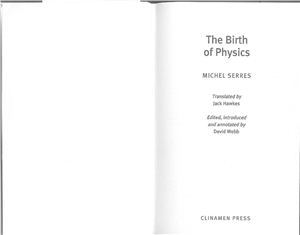Clinamen Press Ltd., Manchester, 2000, Pages: 197
The Birth of Physics focuses on the largest text still intact to reach us from the Ancient Greek Atomists - Lucretius' De Rerum Natura - but mobilises everything we know about the related scientific work of the time (Archemides, Epicurus et al) in order to demand a complete reappraisal of the legacy. Serres argues that the Greeks had all the mathematical resources to formulate an adequate picture of the physical principles acting on matter. Crucial to his reconception of the Atomists' thought is a recognition that their model of atomic matter is essentially a fluid one - they are describing the actions of turbulence. Recognition of this fact throws in relief the force of this ancient thought with respect to the recent disciplines of chaos and complexity. It explains the continuing presence of Lucretius in the work of such scientific giants as Nobel Laureates Schroedinger and Prigogine.
This book is truly a landmark in the study of ancient physics and will promote not only more work in the area but also stimulate a more general rebirth of philosophical interest in the ancients.
The Birth of Physics focuses on the largest text still intact to reach us from the Ancient Greek Atomists - Lucretius' De Rerum Natura - but mobilises everything we know about the related scientific work of the time (Archemides, Epicurus et al) in order to demand a complete reappraisal of the legacy. Serres argues that the Greeks had all the mathematical resources to formulate an adequate picture of the physical principles acting on matter. Crucial to his reconception of the Atomists' thought is a recognition that their model of atomic matter is essentially a fluid one - they are describing the actions of turbulence. Recognition of this fact throws in relief the force of this ancient thought with respect to the recent disciplines of chaos and complexity. It explains the continuing presence of Lucretius in the work of such scientific giants as Nobel Laureates Schroedinger and Prigogine.
This book is truly a landmark in the study of ancient physics and will promote not only more work in the area but also stimulate a more general rebirth of philosophical interest in the ancients.

